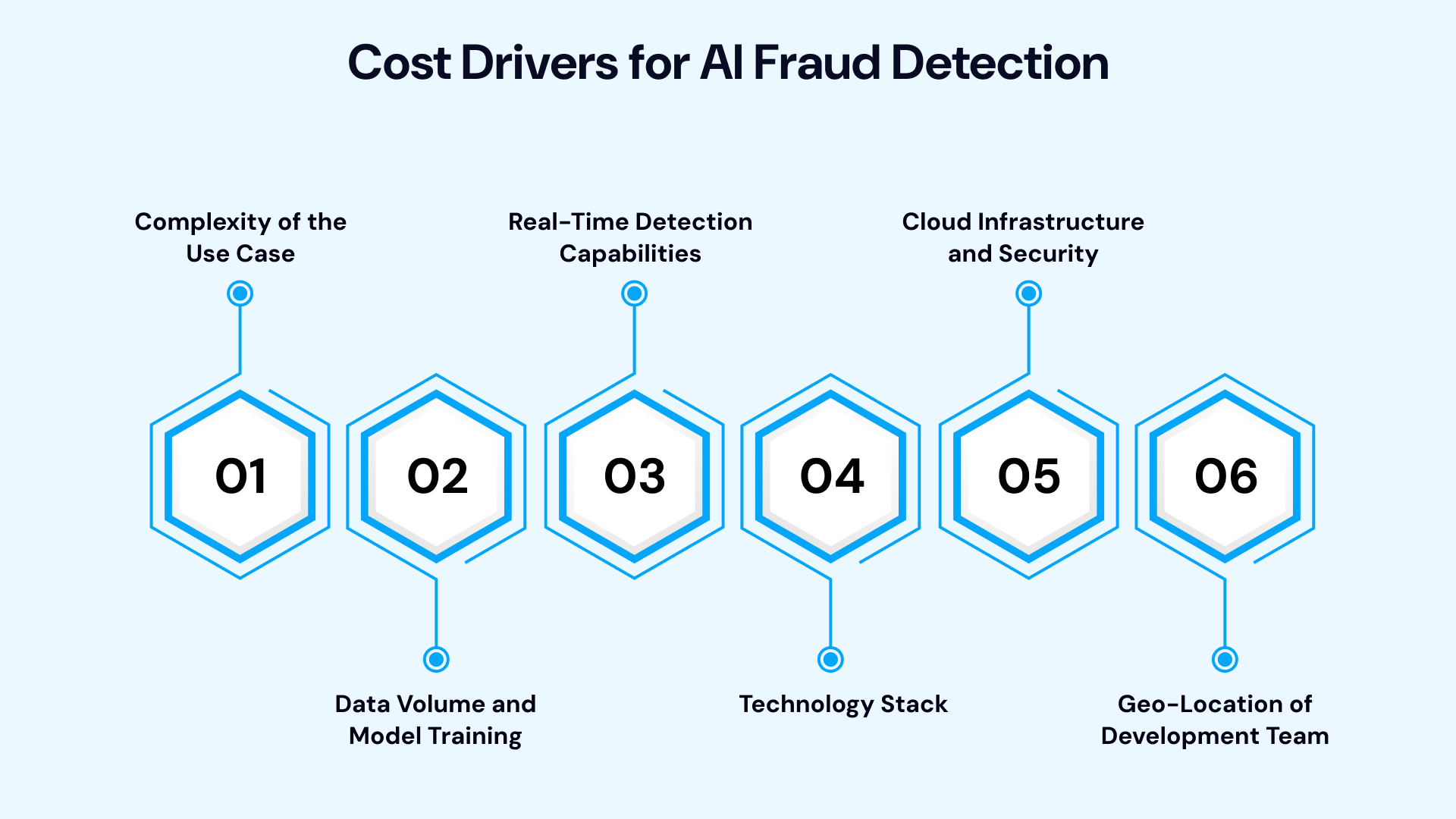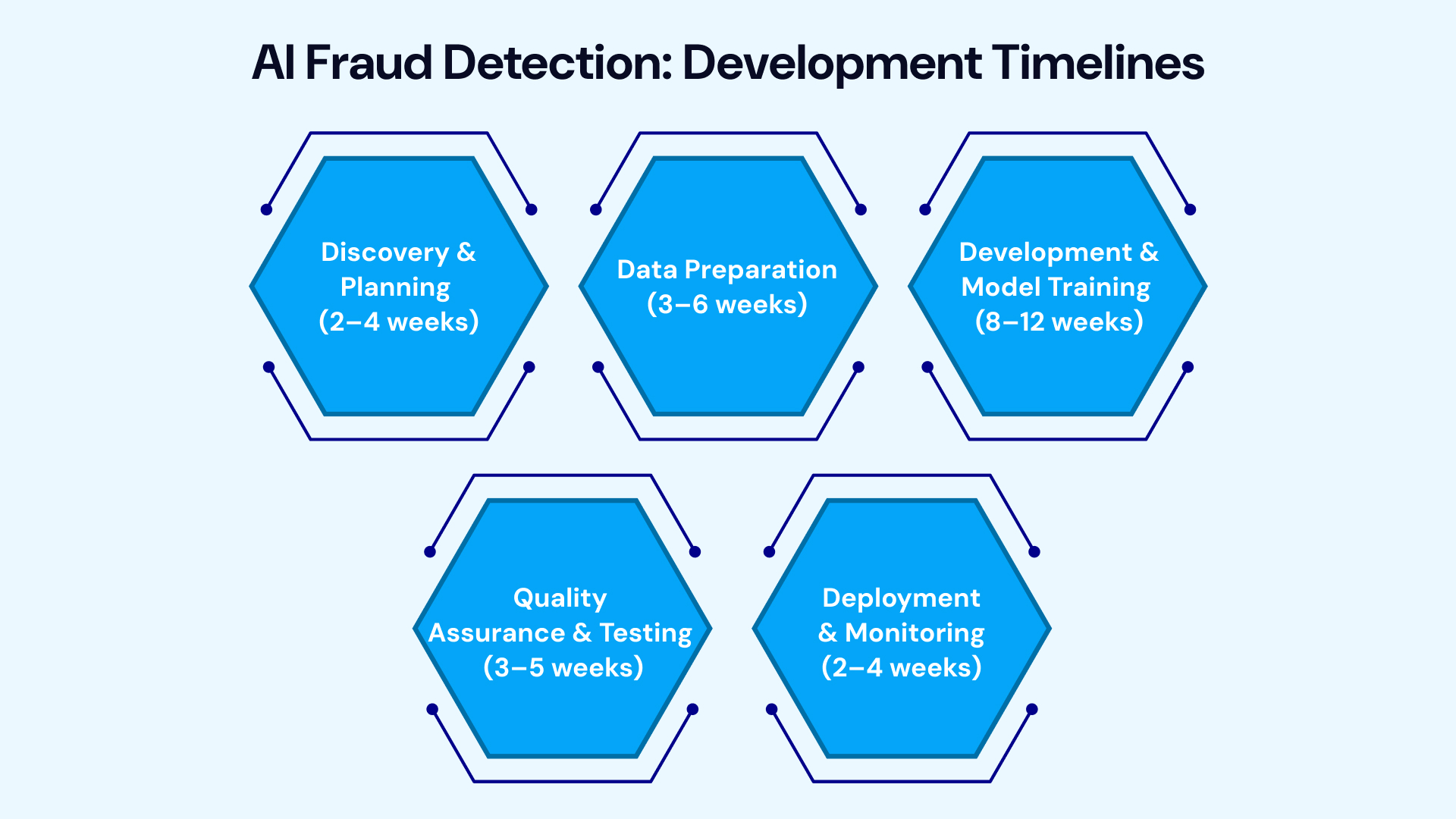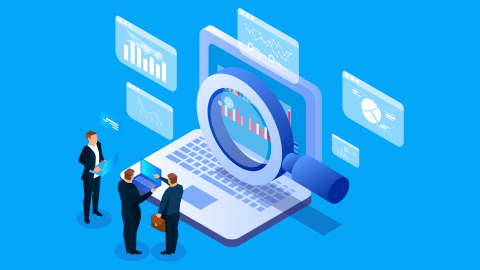The cost of developing an AI fraud detection agent in 2025 is a top concern for businesses facing a surge in digital transactions and increasingly sophisticated cyber threats. With global fraud losses estimated to reach billions annually, organizations in the US and Canada are seeking robust, AI-based fraud detection solutions to protect their assets and customers.
In this comprehensive blog, you’ll get a transparent breakdown of costs, understand the factors that influence pricing, and see how a smart investment in AI can deliver measurable ROI for your business in 2025.
What Is an AI-Based Fraud Detection Agent?
AI fraud detection refers to the use of artificial intelligence and machine learning to identify and prevent fraudulent activities within digital transactions and business operations; unlike traditional systems, which rely on static rules, fraud detection using AI leverages adaptive algorithms to spot anomalies, suspicious behaviors, and emerging fraud tactics in real-time.
Core Components of an AI Fraud Detection Agent:

- Anomaly Detection: This fundamental component is designed to identify outliers – transactions or behaviors that deviate significantly from established, standard patterns. For instance, a sudden large purchase from an unusual location, immediately following a series of small, routine transactions, would trigger an anomaly alert.
- Behavioral Analytics: Beyond individual transactions, AI agents meticulously track and analyze comprehensive user actions and transaction histories. This allows them to build a "normal" behavioral profile for each customer or entity. Any divergence from this profile, such as an unusual login time or a series of rapid, successive transactions, can be flagged as suspicious activity. This includes sophisticated techniques such as behavioral biometrics, which analyze typing rhythms, mouse movements, and navigation patterns to verify user identity.
- Machine Learning Models: The brain of the AI agent, these models continuously learn from new data, improving their detection accuracy over time. They are trained on vast datasets of both legitimate and fraudulent transactions, enabling them to identify subtle patterns that human analysts might miss. As new fraud schemes emerge, the models adapt and refine their understanding, ensuring the system remains effective against novel threats. This often involves techniques like deep learning for more complex pattern recognition.
- Real-time Processing Engines: For many high-stakes applications, such as financial transactions, the ability to detect and act on fraud instantly is paramount. Real-time processing engines allow AI agents to analyze data as it flows through the system, flagging or even blocking suspicious activities within milliseconds.
Types of AI Fraud Detection Agents:
The implementation of AI fraud detection agents can take various forms, each of which offers benefits of real-time fraud detection agents suited to different operational needs:
Real-Time vs. Batch Processing:
- Real-time agents are designed for immediate response, instantly flagging suspicious activity as it occurs. This is crucial for preventing financial losses in high-volume, time-sensitive environments, such as online banking or e-commerce.
- Batch processing systems analyze data in scheduled intervals. While not suitable for immediate prevention, they are valuable for retrospective analysis, identifying trends, and improving future detection models.
Rule-Based vs. Adaptive:
- Rule-based agents follow predefined logic (e.g., "if transaction > $5,000 and location is international, flag"). They are simple to implement but can be easily circumvented by sophisticated fraudsters, often leading to high false positives.
- Adaptive agents are driven by machine learning and continuously evolve in response to new fraud patterns and data inputs. They learn from experience, dynamically adjusting their detection parameters without constant manual intervention, making them far more resilient to new and emerging threats. This is the hallmark of true AI-powered fraud detection.
By seamlessly combining these components and types, AI agents provide a dynamic, scalable, and highly effective approach to combating fraud across various industries, including financial services, e-commerce, healthcare, and insurance.
Why Businesses Are Investing in AI for Fraud Detection
In 2025, the strategic imperative for AI-powered fraud detection systems has never been clearer. Businesses are no longer just considering AI; they are actively prioritizing it as a core component of their cybersecurity and risk management frameworks. This aggressive adoption is driven by a convergence of factors that highlight the undeniable benefits and the severe repercussions of inaction.
Rising Cyber Fraud Trends:
The digital realm, while offering unparalleled opportunities, also presents a fertile ground for malicious actors.
- Escalating Global Cyber Fraud Losses: Global cyber fraud losses continue to rise at an alarming rate, with markets such as the US, UK, and India experiencing particularly severe impacts. The sheer volume and sophistication of attacks necessitate a proactive, adaptive defense.
- AI's Role in Countering Advanced Attacks: A significant 70% of digital platforms are now leveraging AI to defend against increasingly sophisticated attacks, including the alarming rise of deepfakes and bot-driven fraud. These advanced threats, often powered by AI themselves, require an equally intelligent countermeasure. Deepfake fraud cases alone surged by 1,740% in North America between 2022 and 2023, with financial losses exceeding $200 million in the first quarter of 2025. This emphasizes the urgent need for AI-driven deepfake detection tool mechanisms.
Accuracy Improvements with AI:
One of AI's most compelling advantages in fraud detection is its unparalleled accuracy and speed.
- Superior Detection Rates: AI systems are achieving remarkable accuracy, with some reporting up to 96% accuracy in detecting account takeover fraud, significantly outperforming traditional rule-based approaches. This precision reduces financial losses and improves operational efficiency.
- Dramatic Reduction in Detection Time: The average time to detect cybersecurity threats has decreased from a lengthy 72 hours to under 5 minutes with AI integration. This near real-time detection capability is critical for preventing the spread of fraudulent activity and minimizing damage. For instance, in the financial services sector, real-time monitoring and generative AI are enabling banks to achieve a 98% success rate in identifying fraud.
Cost of Not Investing in AI:
The decision to forgo AI in fraud prevention incurs substantial financial and reputational costs.
- Higher False Positives and Customer Friction: Businesses operating without AI-based fraud prevention systems often grapple with a high rate of false positives. This means legitimate transactions are incorrectly flagged as fraudulent, leading to customer inconvenience, frustrated users, and, ultimately, lost revenue due to abandoned transactions and customer churn.
- Significant Financial Losses: The financial repercussions of inadequate fraud prevention are stark. Companies lacking robust AI solutions face an average annual loss due to fraud of $1.4 million, a stark contrast to the significantly lower losses experienced by organizations that leverage advanced technology. Industry studies project that the cost of cybercrime is set to scale up drastically to USD 10.5 trillion annually by 2025.
Key Benefits Beyond Financial Savings
Beyond direct cost reductions and improved detection, AI-driven fraud detection offers a cascade of benefits:
- Prevent Financial Losses and Chargebacks: Direct prevention of fraudulent transactions and the associated chargeback costs.
- Reduce Manual Investigation Workload: Automation of routine fraud checks frees up human analysts to focus on complex, high-value cases.
- Enhance Compliance and Customer Trust: Robust fraud prevention helps meet regulatory requirements and builds customer confidence in the security of their transactions and data. Faster, more accurate detection fosters greater brand loyalty.
In essence, investing in AI-driven fraud prevention technology is no longer an optional strategic choice; it's an essential prerequisite for maintaining competitiveness, ensuring security, and fostering sustainable growth in the dynamic digital economy of 2025.
Key Factors That Affect the Cost of AI Fraud Detection Development
The cost of developing AI-based fraud detection isn't fixed; it's a dynamic figure shaped by several key factors. Understanding these variables is crucial for budgeting, planning, and selecting a solution that aligns with your business needs and financial capabilities.

Here are the primary factors that impact the cost:
- Complexity of the Use Case: Simple fraud detection (e.g., flagging large credit card purchases) is less expensive than advanced, multi-layered systems that analyze diverse data sources (behavioral, device, and network) and detect complex fraud, such as deepfakes. Industry-specific requirements, particularly in regulated sectors such as banking (AML, KYC), also increase costs.
- Data Volume and Model Training: Training robust AI models requires substantial, high-quality, and labeled datasets. Larger data volumes require more computational resources and longer training times, resulting in increased infrastructure and cloud costs. The process of cleaning, annotating, and labeling data is often time-consuming and expensive, potentially requiring specialized data scientists to perform these tasks.
- Real-Time Detection Capabilities: Implementing real-time fraud prevention systems is pricier due to the need for robust, low-latency infrastructure and optimized algorithms to process vast data streams instantly. Batch processing, conversely, is less demanding and more economical.
- Technology Stack: The choice of programming languages (e.g., Python), AI frameworks (e.g., TensorFlow, PyTorch), and development approach (cloud-based services vs. on-premise) directly affects development time and cost. Integrating with existing legacy systems can also be a significant challenge and cost driver.
- Cloud Infrastructure and Security: Deploying AI agents on secure, scalable cloud environments (e.g., AWS, Azure, Google Cloud Platform) incurs ongoing costs for hosting, data storage, and computing resources. Adhering to regulatory compliance (e.g., GDPR, PCI DSS) and implementing robust security features also add to both development and operational expenses.
- Geo-Location of Development Team: Labor rates vary significantly by region. Teams in high-cost areas, such as the US and Canada, command significantly higher hourly rates ($120-$250+) compared to those in lower-cost areas like India or Eastern Europe ($30-$60). While outsourcing can reduce costs, it's essential to consider potential communication challenges and time zone differences.
By carefully evaluating these factors, businesses can develop a realistic budget and a well-informed strategy for their AI fraud detection investment, aiming for the optimal balance between cost, functionality, and long-term value.
Development Cost Breakdown for AI Fraud Detection Agents
To provide a clear financial perspective, let's examine the typical cost for AI software development in fraud detection agents in 2025. These figures represent industry averages and may fluctuate depending on the specific details of your project, the chosen technologies, and the development team's expertise.
| Development Model | Estimated Cost (USD) | Best For |
| In-house team | $120,000–$250,000+ | Large enterprises with unique, highly sensitive data and specific operational needs. |
| Outsourcing (India/Eastern Europe) | $40,000–$90,000 | Startups and Small-to-Midsize Businesses (SMBs) seeking cost-effective solutions and faster deployment. |
| Hybrid Model | $60,000–$130,000 | Mid-size businesses looking for a balance of control, cost-efficiency, and access to specialized expertise. |
Detailed Notes on Development Models:
In-house Development:
- Pros: Offers maximum control over the development process, complete customization to unique business processes, proprietary intellectual property, and a deeply integrated team that understands internal workflows. Ideal for companies where data sensitivity is exceptionally high or where the AI solution is a core competitive differentiator.
- Cons: Comes with significantly higher costs due to salaries, benefits, recruitment expenses, and the need for substantial infrastructure investment (hardware, software licenses, data centers). The time-to-value can also be longer, with projects often taking 12-18 months for enterprise-grade solutions. This approach demands a dedicated internal team with specialized AI/ML skills.
Outsourcing (e.g., India/Eastern Europe):
- Pros: Can dramatically reduce development costs by up to 60%, making advanced AI fraud detection accessible to startups and SMBs. Provides access to a global talent pool of experienced and best AI developers and data scientists, eliminating the overhead of in-house recruitment and management. Offers faster development cycles and specialized expertise.
- Cons: Requires careful vendor selection and management to ensure quality, effective communication, and protection of intellectual property. Time zone differences can sometimes pose minor logistical challenges, though experienced offshore teams are adept at managing these.
Hybrid Model:
- Pros: This model combines the best of both worlds. Often involves local project management, architecture design, and strategic oversight, while core development, model training, and extensive coding are outsourced to cost-effective regions. This approach provides a balance of quality control, cost-effectiveness, and access to a broader range of specialized skills. It enables maintaining strategic control while leveraging external resources for effective execution.
- Cons: Requires strong coordination and communication between internal and external teams. Managing intellectual property and data sharing across different entities needs clear contractual agreements.
Additional Cost Considerations Across All Models
It's crucial to remember that the figures above primarily cover the core development, AI integration, testing, and initial deployment phases. Several other essential costs are typically billed separately or are ongoing:
- Ongoing Maintenance and Support: AI models require continuous monitoring, retraining, and updates to adapt to new fraud patterns and maintain accuracy. This involves data scientists, engineers, and support staff. Expect annual maintenance costs to be around 10-20% of the initial development cost or a subscription fee for SaaS solutions.
- Cloud Hosting and Infrastructure: Ongoing costs for cloud computing, storage, data transfer, and specialized AI services (e.g., GPU instances for model training) are recurring expenses. These can vary significantly based on data volume, real-time processing requirements, and the chosen cloud provider (AWS, Azure, GCP).
- Data Acquisition and Preparation: If your organization lacks sufficient clean, labeled historical data, additional costs may be incurred for data acquisition (e.g., purchasing datasets), extensive data cleaning, and annotation services.
- Compliance and Security Audits: In regulated industries, recurring audits to ensure compliance with data privacy regulations (such as GDPR and CCPA) and security standards (such as PCI DSS and HIPAA) will add to operational costs.
- Training and Change Management: Training internal teams (fraud analysts, customer service) on how to effectively use and interact with the new AI system is an often-overlooked cost.
By understanding these various development models and additional cost implications, businesses can formulate a comprehensive budget and choose the most financially viable and strategically appropriate path for their AI fraud detection journey in 2025.
How Long Does It Take to Build an AI Fraud Detection Agent?
The development timeline for an AI fraud detection agent is a critical factor influencing project planning and budgeting. While simple, off-the-shelf solutions can be deployed quickly, building a robust, custom, and highly effective AI fraud detection system typically requires a methodical, multi-stage process.
On average, you can expect the journey from initial concept to full deployment to span 3 to 6 months; however, complex, enterprise-grade projects may take longer to complete.

Here’s a typical breakdown of the phases involved and their estimated durations:
1. Discovery & Planning (2–4 weeks):
This crucial initial phase involves an in-depth analysis of your business requirements, identifying specific fraud challenges, defining clear success metrics (e.g., reducing target fraud losses, decreasing false positives), and outlining regulatory compliance requirements. It also includes assessing existing infrastructure, data availability, and forming the project team.
2. Data Preparation (3–6 weeks):
The backbone of any successful AI system. This phase involves gathering relevant historical transaction data, customer behavior data, device data, and other pertinent information. A significant portion of this time is dedicated to data cleaning (removing inconsistencies and errors), transformation (formatting for model compatibility), and labeling (categorizing instances as legitimate or fraudulent). This can be highly labor-intensive, especially with large or messy datasets.
3. Development & Model Training (8–12 weeks):
This is the core technical phase. It involves building the fundamental architecture of the AI agent, selecting and implementing appropriate machine learning algorithms (e.g., supervised, unsupervised, deep learning), and training the chosen models on the prepared dataset. Iterative refinement, hyperparameter tuning, and feature engineering are ongoing processes during this stage to optimize model performance. Integration with existing systems and APIs also begins here.
4. Quality Assurance & Testing (3–5 weeks):
Rigorous testing is paramount to ensure the AI agent performs as expected and delivers accurate results. This includes validating model accuracy against unseen data, conducting security checks (such as vulnerability assessments and penetration testing), stress testing the system under high loads, and performing comprehensive user acceptance testing (UAT) with end-users and fraud analysts to ensure usability and effectiveness in real-world scenarios. Addressing identified bugs and refining the model based on test feedback occurs here.
5. Deployment & Monitoring (2–4 weeks):
The final stage involves deploying the AI agent into your production environment. This includes setting up monitoring dashboards to track performance metrics (e.g., fraud detection rate, false positive rate, processing latency), establishing alert systems, and implementing ongoing feedback loops to ensure continuous improvement. Post-deployment, continuous monitoring, and refinement based on real-time operational data are crucial for sustained performance.
Essential Considerations for Timeline Variability:
- Complexity: Highly complex, enterprise-grade projects with numerous data sources, advanced AI techniques (e.g., deep learning for image or voice analysis), and extensive integrations with legacy systems will naturally take longer, potentially extending to 9-12 months or even more.
- Data Readiness: If your organization's data is fragmented, unstructured, or requires significant cleaning and labeling, the data preparation phase can be considerably extended.
- Team Expertise and Resources: The availability and experience of your internal team or chosen outsourcing partner can impact the speed of development.
- Scope Creep: Uncontrolled additions of features or changes in requirements during the development process can significantly delay project completion.
While these timelines provide a helpful benchmark, it's essential to approach each project with a flexible mindset, understanding that unforeseen challenges can arise. Clear communication and agile methodologies can mitigate delays and keep the project on track.
ROI of AI Fraud Detection: Is It Worth the Investment?
Calculating the return on investment (ROI) for AI fraud detection is crucial for making a business case. The good news is that AI-powered systems consistently deliver a high ROI, often exceeding 200–300% within the first year of deployment.
Key ROI Drivers:
- Lower False Positives: Reduces manual reviews and customer friction, saving time and money.
- Real-Time Action: Prevents fraudulent transactions before they impact the bottom line.
- Regulatory Compliance: Minimizes the risk of fines and penalties by ensuring adherence to data security standards and regulations.
- Enhanced Customer Trust: Faster, more accurate fraud detection builds brand reputation and loyalty.
ROI Estimate Table
To illustrate the potential ROI, consider the following estimates for a business effectively deploying an AI fraud detection agent:
| Benefit | Value Estimate (Annual) |
| Fraud loss reduction | $1,000,000+ |
| Manual investigation savings | $250,000 |
| Compliance penalty avoidance | $100,000 |
| Customer retention improvements | 10–20% (indirect financial benefit) |
| Total ROI | 200–300%+ |
These figures are illustrative, highlighting the substantial financial gains that are possible. Financial institutions alone are reportedly saving an average of $7 million annually by leveraging AI for fraud detection. The projected cost savings from AI adoption across various industries are estimated to reach $31 billion by 2025.
While there's an initial cost to build an AI fraud detection system, the investment is overwhelmingly justified by the profound and measurable returns. It's not just about mitigating risk; it's about optimizing operations, safeguarding revenue, and strengthening your competitive position in the digital economy.
Build vs Buy: Which Option Is Right for Your Business?
When considering custom vs. off-the-shelf AI fraud detection, the right choice depends on your business’s scale, requirements, and budget.
Custom Development (Build)
Pros:
- Tailored to unique business processes
- Complete control over features and data
- Competitive differentiation
Cons:
- Higher upfront cost ($60,000–$250,000+)
- Longer development timeline (3–6 months)
- Requires in-house expertise or a reliable outsourcing partner
Off-the-Shelf/SaaS (Buy)
Pros:
- Faster deployment (weeks, not months)
- Lower initial investment (subscription or per-transaction fees, e.g., $20,000/year)
- Vendor support and regular updates
Cons:
- Limited customization
- Ongoing subscription or API costs
- Potential data privacy concerns
Who Should Build vs. Buy?
- Large enterprises with complex needs and data privacy concerns often benefit from building custom solutions.
- Startups and SMBs may prefer SaaS or outsourced development to minimize costs and speed up implementation.
Pro Tips:- Outsourcing to India or similar markets can reduce development costs by up to 60% without compromising quality, provided you choose a reputable vendor
Real-World Example: Case Study Snapshot
To illustrate the practical application and tangible benefits of investing in AI fraud detection, let’s examine a few fraud detection AI agent use cases:
1. Mastercard: 80% Fewer False Declines
- Problem: Legacy systems blocked legitimate transactions, resulting in billions of dollars in costs.
- Solution: AI analyzes spending patterns to distinguish fraud from regular activity.
- Result: 80% reduction in false declines, happier customers.
2. PayPal: Fraud Rate Dropped to 0.32%
- Problem: Payment fraud was on the rise across the industry.
- Solution: AI checks behavioral biometrics (typing speed, device use) and transaction history.
- Result: Fraud rates fell to 0.32% (vs. 1.32% industry average).
3. FinSecure Bank: 60% Less Fraud in 1 Year
- Problem: Outdated systems fail to detect new fraud tactics.
- Solution: AI combines natural language processing (NLP) and network analysis to identify scams.
- Result: Fraud losses were cut by 60%, and false alerts were down by 40%.
Key Takeaways for Businesses
These examples highlight how AI fraud detection agents:
- Reduce false positives by contextualizing transactions (e.g., Mastercard).
- Leverage adaptive learning to stay ahead of evolving threats (e.g., PayPal).
- Integrate multiple AI techniques (NLP, GNNs) for comprehensive protection (e.g., FinSecure)
Enhance Your Business Security: Partner with VLink for AI Fraud Detection
In the complex landscape of AI development for fraud detection, partnering with a seasoned AI development company can make all the difference. At VLink, we understand the nuances of the markets, the escalating threat of sophisticated cyber fraud, and the critical need for ROI-driven solutions.
Our team of senior AI engineers, data scientists, and industry-specific consultants brings unparalleled expertise in designing, developing, and deploying custom AI fraud detection agents tailored to your unique business needs. We leverage cutting-edge machine learning frameworks, ensure robust data security, and build scalable solutions that integrate seamlessly with your existing infrastructure.
Whether you're a large enterprise seeking bespoke, real-time fraud prevention or a growing small business looking for a cost-efficient yet powerful solution, VLink’s dedicated team offers the strategic guidance and technical expertise to turn your vision into reality. We prioritize transparent communication, agile development methodologies, and delivering measurable results that safeguard your assets, enhance customer trust, and drive profitability.
Choose VLink to ensure your investment in AI fraud detection is not just an expense but a strategic advantage that puts you ahead of the curve.
Conclusion
The digital frontier of 2025 demands vigilant defense, and AI-powered fraud detection agents stand as your most formidable shield. We've thoroughly unpacked the cost of the AI fraud detection agent, revealing that while the initial investment can vary significantly from $40,000 for efficient outsourced solutions to over $250,000 for complex, in-house enterprise-grade systems, it's an investment with profound and quantifiable returns.
The evidence is clear: the ROI on AI fraud detection isn't just compelling; it's transformative. By leveraging the power of AI, businesses in the US and Canada can expect to see dramatic reductions in fraud-related losses, significant savings from minimizing false positives, and a streamlined operational workflow that frees up valuable human resources. Beyond the direct financial gains, enhanced regulatory compliance and bolstered trust in your customer base provide invaluable, long-term benefits that solidify your market position.
Ready to protect your business and boost profitability? Contact us now and discover the best fraud detection solution for your needs.










 Shivisha Patel
Shivisha Patel

















